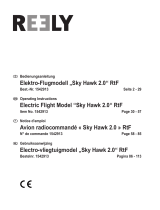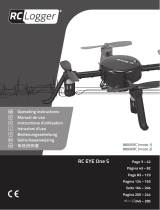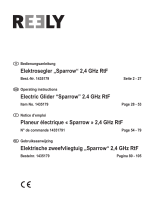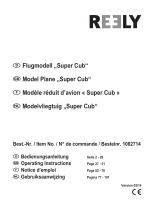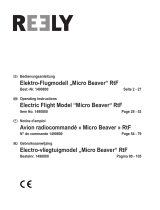Page is loading ...

Operating Instructions
ARCUS E-RISE
500 RTF 2.4 GHz
No. 2562

Operating instructions - ARCUS E-RISE 500 RTF 2.4 GHz No. 2562
2

Explanation of specialist terms:
Motor speed ("Throttle"): This controls the rotati-
onal speed of the motor. Stick forward = maximum
speed; stick back = motor off.
Rudder: This controls the model's attitude around
the vertical (yaw) axis, causing the aeroplane to fly
to the right or left.
Up-elevator / down-elevator: This controls the
model's flight attitude around the lateral (pitch)
axis. Stick forward = the model descends; stick
back = the model climbs.
Ailerons: This controls the model's flight attitude
around the longitudinal (roll) axis. Stick right = right
wing down; stick left = left wing down.
Mode 1: Function assignment of the control move-
ments relative to the stick movements.
In this case throttle and ailerons are controlled by
the right-hand transmitter stick, elevator and rudder
by the left-hand stick.
Mode 2: Function assignment of the control move-
ments relative to the stick movements.
In this case throttle and rudder are controlled by
the left-hand transmitter stick, elevator and ailerons
by the right-hand stick.
Dual-Rates:
Switchable travel reduction for control movements.
3
Contents Page
Explanation of specialist terms / Contents 3
Safety Notes 4, 5
Set contents / Specification 6
Assembling the model 7
Charging the flight battery / LiPo battery safety notes 8
Summary of transmitter settings in Mode 1 und Mode 2 9
Primary and expanded control functions / converting the transmitter 10
Transmitter settings in Mode 1 11
Transmitter settings in Mode 2 12
Flight preparation 13
Controlling the model 14
Important notes 15
Re-binding the transmitter 16
Replacement parts list 17
Notes 18
General notes 19
Operating instructions - ARCUS E-RISE 500 RTF 2.4 GHz No. 2562

Be sure to read these Safety Notes before you build your model.
Always keep to the procedures and settings recommended in the
instructions.
If you are operating a radio-controlled model aircraft, helicopter, car
or boat for the first time, we recommend that you enlist the aid of an
experienced modeller to help you.
Safety Notes
Radio-controlled models are not toys in the usual sense of the term.
Young persons under fourteen years should only be allowed to operate
them under the supervision of an adult.
Building and operating these models requires technical expertise, manu-
al skills, a careful attitude and safety-conscious behaviour.
Errors, negligence and omissions in building or flying these models can
result in serious personal injury and damage to property.
Since the manufacturer and vendor are not in a position to check that
your models are built and operated correctly, all we can do is bring these
hazards expressly to your attention. We deny all further liability.
Aircraft propellers, and all moving parts generally, constitute
a constant injury hazard.
It is essential to avoid touching such parts.
Please bear in mind that motors and speed controllers may
become hot when operating.
It is essential to avoid touching such parts.
Do not stand close to the hazard area around rotating parts when
an electric motor is connected to the flight battery.
You must also take care to keep all other objects away from mo-
ving or rotating parts.
Observe the instructions provided by the battery manufacturer.
Overcharged or incorrectly charged batteries may explode. Take
care to maintain correct polarity.
Notes on the use of dry cells:
Do not attempt to recharge dry cells, do not open them, and do not
incinerate them. Remove exhausted dry cells from the transmitter
after use. Escaped electrolyte may ruin the transmitter.
Ensure the equipment is protected from dust, dirt and moisture conta-
mination. Do not subject the system to excessive heat, cold or vibration.
Use the recommended charger only, and charge the batteries only for the
prescribed period.
Check your equipment for damage at regular intervals, and replace de-
fective components with genuine spare parts.
Do not re-use any devices which have been damaged in a crash or by
water, even when they have dried out again.
Send the equipment to the robbe Service Department for checking, or
replace the parts in question.
Crash or water damage can result in concealed defects which may lead
to failure in subsequent use.
4
Operating instructions - ARCUS E-RISE 500 RTF 2.4 GHz No. 2562

Use only those components and accessories which we specifically re-
commend.
Do not carry out modifications to the radio control system components
apart from those described in the instructions.
Operating the model
•Neveryoverortowardsspectatorsorotherpilots,andmaintainasafe
distance from them at all times.
•Neverendangerpeopleoranimals.
•Nevery or run the modelclose to high-tension overheadcables or
residential areas.
•Donotoperateyourmodelinthevicinityofcanallocksoropenwater-
ways.
•Donotoperateyourmodel frompublicroads,motorways,pathsand
squares etc.; use authorised model flying sites only.
• Never operate your equipment in stormy weather.
Never “point” the transmitter aerial straight at the model when operating
it. The transmitter signal is at its weakest in this direction. It is always best
to stand with the long side of the aerial angled towards the model.
Insurance
Ground-based models are usually covered by standard personal third-
party insurance policies. In order to fly model aircraft you will need to
extend the cover of your existing policy, or take out specific insurance.
Check your insurance policy and take out new cover where neces-
sary.
Liability Exclusion
robbe Modellsport is unable to ensure that you observe the assembly and
operating instructions, or the conditions and methods used for installing,
operating and maintaining the model components.
For this reason we accept no liability for loss, damage or costs which are
due to the erroneous use and operation of our products, or are connected
with such operation in any way.
Regardless of the legal argument employed, our obligation to pay com-
pensation is limited to the invoice value of those robbe products directly
involved in the event in which the damage occurred, unless otherwise
prescribed by law. This does not apply if the company is deemed to have
unlimited liability according to statutory regulation due to deliberate or
gross negligence.
5
Operating instructions - ARCUS E-RISE 500 RTF 2.4 GHz No. 2562

Dear customer,
Congratulations on choosing a model aircraft from our ran-
ge. Many thanks for placing your trust in us.
The model can be completed and made ready to fly very
quickly. Please read right through these instructions before
attempting to fly the model for the first time, as this will
make it much easier to operate the model safely.
All directions, such as “right-hand”, are as seen from the
tail of the model, looking forward.
Specification:
Wingspan: 500 mm
Overall length: 350 mm
All-up weight: ca. 40 g
Motor: N20
Power supply: LiPo battery, 3.7 V / 150 mAh
Set contents:
1 x ARCUS E-RISE 500 RTF 2.4 GHz
1 x 2.4 GHz transmitter
1 x Lithium-Ion-Polymer battery
4 x AA-size dry cells
Please be sure to observe the safety notes regar-
ding the handling of Lithium-Ion-Polymer rechar-
geable batteries on plage 8.
6
Operating instructions - ARCUS E-RISE 500 RTF 2.4 GHz No. 2562

7
Assembling the model
Place the wing in the fuselage, and set it at right-angles to the fuselage centreline.
This is accomplished by sliding the wing leading edge into the locating recess.
The wing is retained by a magnet at the trailing edge (Figs. 1 + 2).
Fig. 1
Fig. 2
Operating instructions - ARCUS E-RISE 500 RTF 2.4 GHz No. 2562

Charging the flight battery using the transmitter
8
LIABILITY EXCLUSION
Since robbe Modellsport is not in a position to monitor the
handling of these batteries, we expressly deny all liability and
guarantee claims where the batteries have been incorrectly
charged, discharged or handled.
The system can only work reli-
ably if the transmitter batteries
are fully charged.
Open the cover over the
transmitter's charge bay, and
place the flight battery inside.
Switch the transmitter on: the
green LED on the transmitter
lights up to indicate that char-
ging is in progress. The battery
is fully charged when the green
LED goes out. Remove the bat-
tery, close the transmitter, and
switch it off.
Safety Notes
Do not operate your charger and batteries on an inflam-
mable surface, and do not leave the equipment running
unsupervised. Protect from damp. Do not subject to direct
sunshine.
Do not charge batteries that are hot to the touch. Allow
batteries to cool down to ambient temperature.
Operating instructions - ARCUS E-RISE 500 RTF 2.4 GHz No. 2562
Safety Notes regarding LiPo batteries:
•Donotplacethebatteryinwateroranyotherliquid.
•Donotheatorincineratethebattery;donotplaceit
in a microwave oven.
•Avoidshort-circuits,andneverchargethebatterywith
reversed polarity
•Donotsubjectthebatterytopressureorshockloads,and
never distort or throw the pack.
•Neversolderdirectlytothebattery
•Donotmodifyoropenthebattery
•Batteriesmustonlybechargedwithasuitablecharger;
never connect the battery directly to a mains power supply.
•Neverchargeordischargeabatteryinbright
sunlight, or close to a heater or open fire.
•Donotusethebatteryinareassubjecttohighlevelsof
static discharge.
•Anyoftheseerrorscanresultindamagetothebattery,
explosion or even fire.
•Keepthebatteryoutofthereachofchildren
•Donotallowescapedelectrolytetocomeintocontact
with fire, as it is highly inflammable, and may ignite.
•Avoidtheuidelectrolytecontactingtheeyes.
If this should happen, flush with copious amounts of clean
water and contact a doctor without delay.
•Theuidelectrolytecanalsoberemovedfromclothing
and other objects by rinsing in plenty of water.

9
Transmitter settings, Mode 1: Transmitter settings, Mode 2 (as supplied):
Elevator
control
Elevator trim
Rudder trim
Throttle
control
and
rudder
control
Throttle
trim Screen
Dual-Rate status indicator
Elevator
Trim display
Status indicator
Transmitter
battery
Throttle status indicator
Rudder trim
Screen
Elevator
control
and
rudder
control
Rudder trim
Throttle
control
Elevator trimThrottle trim
Throttle status indicator
Status indicator
Transmitter
battery
Status indicator
Dual-Rate
Elevator
trim display
Throttle trim
Screen
Rudder trim display
Throttle trim
Operating instructions - ARCUS E-RISE 500 RTF 2.4 GHz No. 2562

10
"Primary" and "expanded" control function setting
The transmitter offers the facility to adjust the sensitivity
of the stick movements. We recommend "softer" reduced
travels for beginners.
Open the transmitter battery compartment and insert the
four AA cells* (check for correct polarity).
Switching sensitivity:
Switch the transmitter on, and
press the right-hand stick in.
If you have converted the transmitter to Mode 1, the left-
hand stick must be pressed in.
* Please read the information regarding dry cells on page 4.
Reduced control function
The full black disc on the
"Dual-Rate status indicator" disc is
reduced to half.
Enlarged control function:
Press the right-hand stick in again.
The full black disc on the
screen now reappears.
Mode 2
Converting the transmitter from "Mode 2"
(throttle left)
to "Mode 1" (throttle right)
The transmitter is supplied set to Mode 2 as standard. If
you prefer Mode 1 and wish to convert the transmitter to
that mode, use this procedure:
The transmitter must be switched off.
Release the clip over the aerial
using a cross-point screwdriver.
Raise the aerial out of its recess and
set it at 90°.
Now turn the aerial through 180°
and place it in the recess again,
pointing in the opposite direction.
Place the clip over the aerial and
screw it in place. Re-positioning
the aerial in this way shifts throttle
control to the right-hand side.
Switch the transmitter on, and pull
the throttle trim back (towards you).
Check the new stick mode (Mode 1).
Operating instructions - ARCUS E-RISE 500 RTF 2.4 GHz No. 2562

11
Transmitter settings Mode 1
Throttle trim:
If the propeller starts to move without
you touching the throttle stick, or does
not respond to stick movements, cor-
rect this with the throttle trim.
Rudder trim:
If the model's nose turns to right or left
when launched, adjust the rudder trim
buttons until the model maintains a
constant heading.
Elevator trim:
If the model raises or lowers its nose
when launched, adjust the elevator
trim until the model maintains a stable
attitude.
a
a
a
a
a
a
a
a
a
a
a
a
Operating instructions - ARCUS E-RISE 500 RTF 2.4 GHz No. 2562

12
Transmitter settings Mode 2
Throttle trim:
If the propeller starts to move without
you touching the throttle stick, or does
not respond to stick movements, cor-
rect this with the throttle trim.
Rudder trim:
If the model's nose turns to right or left
when launched, adjust the rudder trim
buttons until the model maintains a
constant heading.
Elevator trim:
If the model raises or lowers its nose
when launched, adjust the elevator
trim until the model maintains a stable
attitude.
a
a
a
a
a
a
a
a
a
a
a
a
Operating instructions - ARCUS E-RISE 500 RTF 2.4 GHz No. 2562

13
Flight preparation
Switch the transmitter on (Fig. 1). The battery status is
shown on the left of the screen. Move the throttle stick
and trim to the lowest position. Slide the fully-charged LiPo
flight battery into the holder in the bottom of the fuselage
(Fig. 2).
The transmitter and the receiver are now ready for use.
Repeat this procedure every time you wish to fly the model.
The Centre of Gravity (see illustration on page 15) is che-
cked by supporting the model under the wings on both
sides of the fuselage using your index fingers, and allow-
ing it to hang freely. Ideally the model will now balance
level, with the nose inclined slightly down.
Note: the 2.4 GHz transmitter and receiver are supplied
already bound at the factory. It will only be necessary to
bind the system again after a repair, or if you replace a
component.
The correct pre-flight procedure.
Fig. 1 Fig. 2
Checking the working systems
Before the first flight it is important to set all the trims - ex-
cept for the throttle trim - to centre. The throttle stick must
be in the "fully back" position (towards you). If the propeller
turns, adjust the throttle trim until it comes to a halt.
The correct post-flight procedure.
Remove the flight battery from the holder in the bottom of
the fuselage, then switch the transmitter off.
Preparations for the first flight:
Wait for a day with absolute flat calm conditions.
Charge the flight battery before flying.
Operating instructions - ARCUS E-RISE 500 RTF 2.4 GHz No. 2562

14
RPM off (landing):
Right turn:
Climb:
High RPM (launch):
Left turn:
Descent:
High RPM (launch):
Left turn:
Descent:
Controlling the model in Mode 1
Motor off (landing):
Right turn:
Climb:
Controlling the model in Mode 2
Operating instructions - ARCUS E-RISE 500 RTF 2.4 GHz No. 2562

15
Once the model is properly trimmed, you can practise the
art of flying, and carry out manoeuvres such as circles,
squares, rectangles and figures-of-eight.
To avoid giving incorrect control commands, always stand
behind and to one side of the model.
You can fly a square pattern by alternating the direction
of flight: away from the pilot, to the pilot's right, and then
towards the pilot.
Tip: when the model is flying with the nose pointing
towards you, the controls are reversed (apart from
elevator and throttle control).
Important Notes
Launching: Hold the model in your hand, set the motor to full po-
wer, and push the model forward smartly, directly into any wind.
It is essential to adjust the trims so that the aeroplane flies in a
stable attitude, climbing gently. Use the controls gently at first to
learn how the model responds to flight commands.
Landing: Slowly and steadily reduce the throttle setting until the
model descends and touches down. Never reduce the throttle
setting abruptly. After the landing disconnect the flight battery
from the receiver, and only then switch the transmitter off.
Caution: Stopping (obstructing) the motor when it is turning can
cause serious damage to the mechanical system, and may even
result in a fire. If the propeller is forcibly stopped, immediately
move the throttle stick back to Idle!
Note regarding the flight battery: As soon as you notice a red-
uction in motor power, land immediately and disconnect the bat-
tery. Never continue flying until the battery is flat, as this causes
a deep-discharge condition, which results in permanent damage.
Allow the battery to cool down before recharging it.
Replacing the propeller: A damaged propeller must be re-
placed immediately.
The first few flights
Operating instructions - ARCUS E-RISE 500 RTF 2.4 GHz No. 2562

16
Re-binding the transmitter
This procedure is only necessary after replacing individual components.
Move the throttle stick to the Idle position.
Hold the throttle stick pressed in while you switch the transmitter on (Fig. 1). The
screen now flashes. Slide the LiPo battery into the model.
Note: if you have converted the transmitter to Mode 1, you must press in the
right-hand stick (Fig. 2).
When the re-binding process is complete, the screen stops flashing and reverts
to the normal display (Fig. 3)
Fig. 1
Fig. 2Fig. 3
Operating instructions - ARCUS E-RISE 500 RTF 2.4 GHz No. 2562

17
NE220009
NE200206
NE200207
25620002
NE200204
Replacement parts list -
ARCUS E-RISE 500 E RTF
Order No. Description
25620001 Fuselage
25620002 Wing
25620003 Tail set
25620004 Propeller set
25620005 Decal sheet (not shown)
NE200204 Control surface linkage
NE200206 Motor set
NE200207 Receiver set
NE200208 Battery charger and mains PSU (not shown)
NE220009 LiPo battery, 3.7 V / 150 mAh
When replacing components it is very important
to use the correct type of cross-point screwdri-
ver and to tighten the screws with great care.
Do not use thread-lock fluid!
25620001
25620003
25620004
Operating instructions - ARCUS E-RISE 500 RTF 2.4 GHz No. 2562

19
This symbol means that you should dispose of electrical and electronic equipment separately from the household waste when it reaches
the end of its useful life. Take your unwanted equipment to your local council collection point or recycling centre. This requirement applies to
member countries of the European Union as well as other non-European countries with a separate waste collection system.
Disposal of batteries
Batteries must not be discarded as domestic refuse. To protect the environment, always return exhausted or defective cells to your local
recycling centre. These include retail sales outlets for batteries, and communal toxic waste disposal centres. Cover any bare wires with
insulating tape in order to avoid short-circuits.
robbeModellsportGmbH&Co.KGherebydeclaresthatthisdeviceconformstothefundamentalrequirementsandotherrelevant
regulations of the appropriate CE Directive. Under www.robbe.com, you will find the original Conformity Declaration by clicking on the Logo
button "Conform" shown together with the appropriate device description.
Operating instructions - ARCUS E-RISE 500 RTF 2.4 GHz No. 2562

robbe Modellsport GmbH & Co.KG
Metzloserstraße 38 · D-36355 Grebenhain
Technical hotline: +49 (0)66 44 / 87-777 · hotline@robbe.com
Commercial register: Gießen Regional Court HRA 2722
Partner with personal liability:
robbe Modellsport Beteiligungs GmbH Gießen / HRB 5793 · Managing Directors: G. Geiger, E. Dörr
Errors and technical modifications reserved. · Copyright robbe-Modellsport 2011
Duplicationandcopyingofthetext,inwholeorinpart,isonlypermittedwiththepriorwrittenapprovalofrobbe-ModellsportGmbH&Co.KG
20
Operating instructions - ARCUS E-RISE 500 RTF 2.4 GHz No. 2562
/
